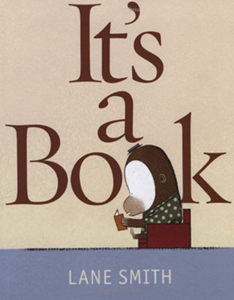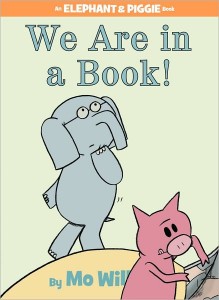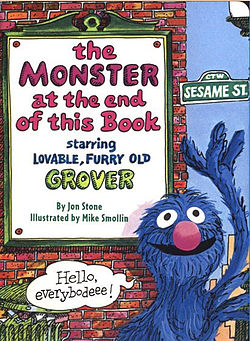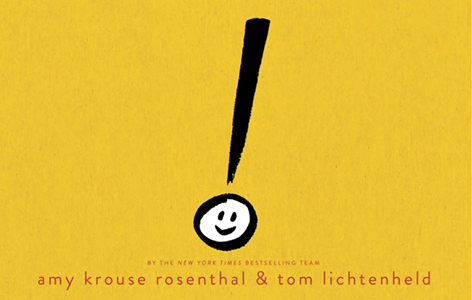
The Horn Book website has lots of material of interest to teachers. Here are some areas to explore. And follow us on Twitter: #lollysclass
|
Interviews with authors and illustrators Recommended books -- reviews and themed book lists |
School -- reading in school, author visits, and more Suggestion box: what else to you want to see in Lolly's Classroom? |
Top 5 meta books to teach print concepts
As a Pre-K teacher, one of the things I am focused on is helping children learn concepts of print.
 It’s a Book by Lane Smith
It’s a Book by Lane SmithI have seen children not old enough to crawl who know how to operate an iPad. This fact has inspired countless think pieces and studies regarding the benefits and drawbacks of both traditional books and books on tablets and computers. Lane Smith’s It’s A Book plays off of this divide between traditionalists and digital book readers in a way that will amuse both children and adults. In the story, we get one character pestering the other with persistent questions about the book he is reading such as “Can it text? Tweet? Blog?” Since many five year olds are already familiar with tablets and smart phones, this book can inspire discussions regarding the differences between digital books and traditional print books, and how those books work. (Note to educators and parents: the end of the book refers to the Donkey as a “Jackass.”)
 We Are In a Book! by Mo Willems
We Are In a Book! by Mo WillemsMost readers of Lolly’s Classroom are most likely already familiar with Mo Willems Elephant and Piggie series. One of my class’s favorites in the series is the meta book We Are In A Book! In this book, Elephant and Piggie discover that they are in fact in a book and go on to explain how books work in a myriad of funny scenes. For example, Piggie informs Elephant that “a reader is reading us” which leads to the two characters trying to get the reader to say random silly words like “banana.” Concepts like page numbers and that all books end are also learned via the plot line.
 The Book With No Pictures by B. J. Novak
The Book With No Pictures by B. J. NovakMost got to know Newton native B. J. Novak when he played Ryan Howard on the TV show The Office. Since the completion of the show, Novak has expanded his artistic oeuvre to include writing a children’s book called The Book With No Pictures. As you probably guessed from the title, this book contains no pictures. Instead, the book forces the adult who is reading the story to say ridiculous things like “blork,” “Bluurf,” and “I am a monkey who taught myself to read.” This is a great book to teach children that text can have meaning without pictures and can inspire a fun lesson plan for emerging writers by having the children try to author their own book with no pictures.
 The Monster At The End Of This Book by Jon Stone
The Monster At The End Of This Book by Jon StoneIn this book staring the iconic Sesame Street character, Grover sees the title and is fearful of the monster at the end of the book. As the reader turns the book, Grover gets increasingly scared and angry at the reader who, by turning the pages, is bringing him ever closer to the monster at the end of the book. (I won’t spoil the ending, but you can probably guess who the monster turns out to be.)
 ! by Amy Krouse Rosenthal, illustrated by Tom Lichtenheld
! by Amy Krouse Rosenthal, illustrated by Tom LichtenheldPunctuation can be confusing to young children; fortunately, Amy Krouse Rosenthal and Tom Lichtenheld teamed up to create this great book simply titled !. In the story, the characters themselves are punctuation marks. At the beginning, we find the exclamation mark upset because he does not fit in with the periods. Eventually, the exclamation marks sets off and meets a question mark who can’t stop asking him questions, which leads to the exclamation mark finding his voice and purpose. This is a great book to read to set up a lesson plan about how different punctuation can change the tone and meaning of a sentence.
Finally, I will leave you with a simple lesson plan to create a “meta book” called “I Am In a Book” Get some small pieces of poster board and onto each piece of poster board attached a self-adhesive mirror tile (they are pretty cheap to buy). Use a hole-punch and book ring to turn it into a book. On the cover write “I am in a book”. On each subsequent page write phrases like “this is my happy face,” “this is my mad face," "this is my sad face," "this is my silly face," and so on. As the children read the book they will make the face that goes along whatever is written underneath the mirror on that page.
RELATED
RECOMMENDED
ALREADY A SUBSCRIBER? LOG IN
We are currently offering this content for free. Sign up now to activate your personal profile, where you can save articles for future viewing.







Add Comment :-
Comment Policy:
Comment should not be empty !!!